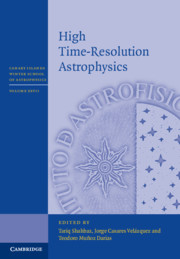Refine listing
Actions for selected content:
17002 results
2 - HTRA Instrumentation I
-
- Book:
- High Time-Resolution Astrophysics
- Published online:
- 31 July 2018
- Print publication:
- 02 August 2018, pp 43-66
-
- Chapter
-
- You have access
- Export citation
Frontmatter
-
- Book:
- High Time-Resolution Astrophysics
- Published online:
- 31 July 2018
- Print publication:
- 02 August 2018, pp i-vi
-
- Chapter
- Export citation
Abbreviations
-
- Book:
- High Time-Resolution Astrophysics
- Published online:
- 31 July 2018
- Print publication:
- 02 August 2018, pp xiv-xvi
-
- Chapter
- Export citation
Acknowledgements
-
- Book:
- High Time-Resolution Astrophysics
- Published online:
- 31 July 2018
- Print publication:
- 02 August 2018, pp xiii-xiii
-
- Chapter
- Export citation
6 - Incorporating Gamma-ray Data into High-Time Resolution Astrophysics
-
- Book:
- High Time-Resolution Astrophysics
- Published online:
- 31 July 2018
- Print publication:
- 02 August 2018, pp 169-194
-
- Chapter
- Export citation
5 - Radio Observations and Theory of Pulsars and X-ray Binaries
-
- Book:
- High Time-Resolution Astrophysics
- Published online:
- 31 July 2018
- Print publication:
- 02 August 2018, pp 133-168
-
- Chapter
- Export citation
Participants
-
- Book:
- High Time-Resolution Astrophysics
- Published online:
- 31 July 2018
- Print publication:
- 02 August 2018, pp ix-x
-
- Chapter
- Export citation
3 - HTRA Instrumentation II
-
- Book:
- High Time-Resolution Astrophysics
- Published online:
- 31 July 2018
- Print publication:
- 02 August 2018, pp 67-96
-
- Chapter
- Export citation
1 - Radiation Processes and Models
-
- Book:
- High Time-Resolution Astrophysics
- Published online:
- 31 July 2018
- Print publication:
- 02 August 2018, pp 1-42
-
- Chapter
- Export citation
Preface
-
- Book:
- High Time-Resolution Astrophysics
- Published online:
- 31 July 2018
- Print publication:
- 02 August 2018, pp xi-xii
-
- Chapter
- Export citation

High Time-Resolution Astrophysics
-
- Published online:
- 31 July 2018
- Print publication:
- 02 August 2018
14 - Making Chondrules by Splashing Molten Planetesimals
- from Part II - Possible Chondrule-Forming Mechanisms
-
-
- Book:
- Chondrules
- Published online:
- 30 June 2018
- Print publication:
- 19 July 2018, pp 361-374
-
- Chapter
- Export citation
16 - Evaluating Non-Shock, Non-Collisional Models for Chondrule Formation
- from Part II - Possible Chondrule-Forming Mechanisms
-
-
- Book:
- Chondrules
- Published online:
- 30 June 2018
- Print publication:
- 19 July 2018, pp 400-427
-
- Chapter
- Export citation
Index
-
- Book:
- Chondrules
- Published online:
- 30 June 2018
- Print publication:
- 19 July 2018, pp 437-440
-
- Chapter
- Export citation
7 - Chondrules in Enstatite Chondrites
- from Part I - Observations of Chondrules
-
-
- Book:
- Chondrules
- Published online:
- 30 June 2018
- Print publication:
- 19 July 2018, pp 175-195
-
- Chapter
- Export citation
1 - Introduction
-
-
- Book:
- Chondrules
- Published online:
- 30 June 2018
- Print publication:
- 19 July 2018, pp 1-8
-
- Chapter
- Export citation
10 - Tungsten Isotopes and the Origin of Chondrules and Chondrites
- from Part I - Observations of Chondrules
-
-
- Book:
- Chondrules
- Published online:
- 30 June 2018
- Print publication:
- 19 July 2018, pp 276-299
-
- Chapter
- Export citation
17 - Summary of Key Outcomes
- from Part II - Possible Chondrule-Forming Mechanisms
-
-
- Book:
- Chondrules
- Published online:
- 30 June 2018
- Print publication:
- 19 July 2018, pp 428-436
-
- Chapter
- Export citation
3 - Thermal Histories of Chondrules
- from Part I - Observations of Chondrules
-
-
- Book:
- Chondrules
- Published online:
- 30 June 2018
- Print publication:
- 19 July 2018, pp 57-90
-
- Chapter
- Export citation
Plate Section (PDF Only)
-
- Book:
- Chondrules
- Published online:
- 30 June 2018
- Print publication:
- 19 July 2018, pp 441-441
-
- Chapter
- Export citation
